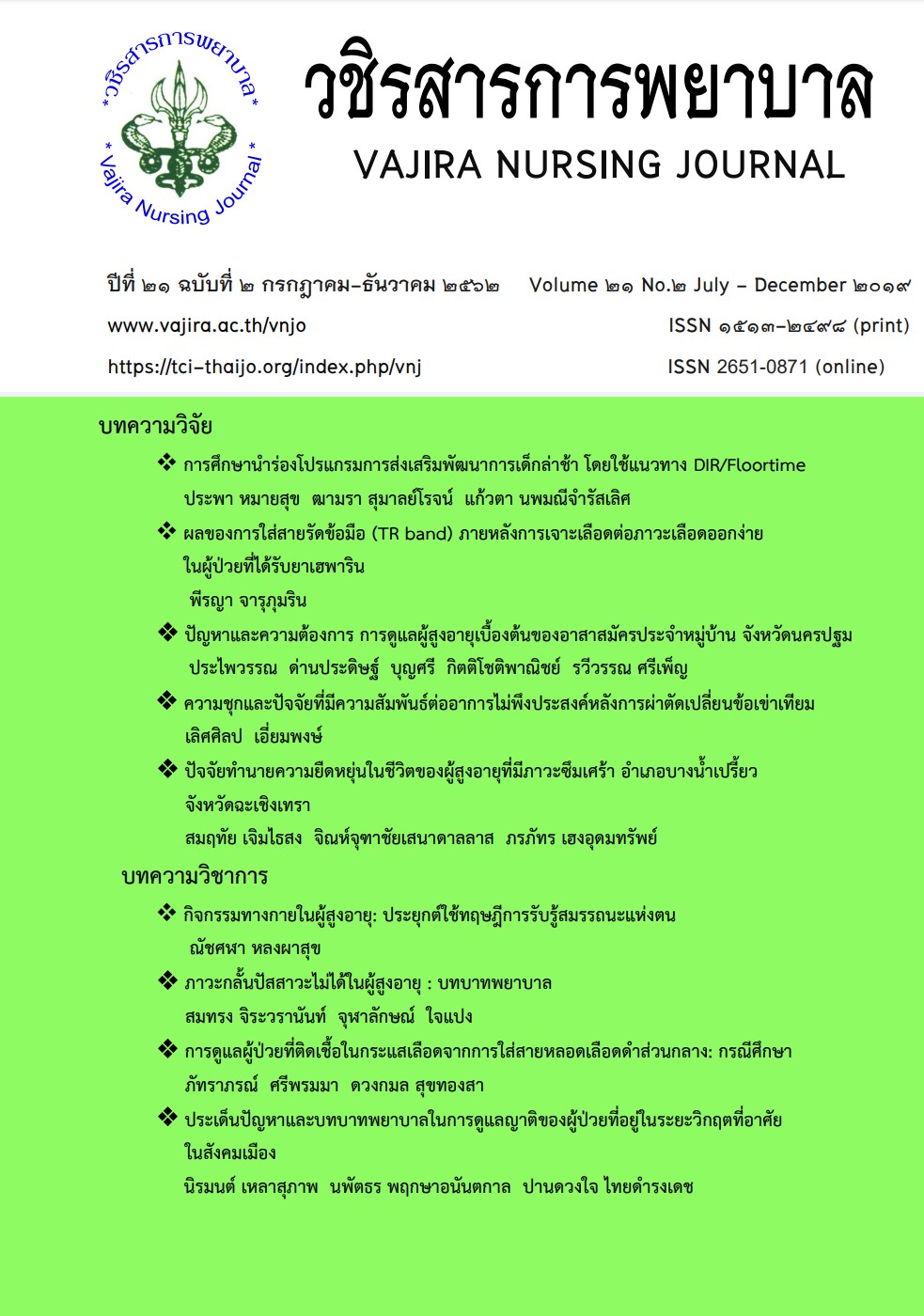การดูแลผู้ป่วยที่ติดเชื้อในกระแสเลือดจากการใส่สายหลอดเลือดดำส่วนกลาง: กรณีศึกษา กรณีศึกษา
Main Article Content
บทคัดย่อ
การใส่สายสวนหลอดเลือดดำส่วนกลาง (central venous catheter) มีความจำเป็นในการติดตาม hemodynamic ของผู้ป่วย เป็นทางให้ยาและสารน้ำสารอาหาร ในการดูแลผู้ป่วยที่ใส่สายสวนหลอดเลือดดำนั้นต้องตระหนักตั้งแต่ขั้นตอนการเตรียมผู้ป่วยก่อนใส่สายสวน ขณะใส่สายสวน และภายหลังการใส่สายสวน ปัจจุบันการเกิดภาวะแทรกซ้อนหลังการใส่สายสวนที่เป็นปัญหาสำคัญคือ การติดเชื้อในกระแสเลือดจากการใส่สายสวนหลอดเลือดดำส่วนกลาง (central line associated blood stream infection; CLABSI) ซึ่งทำให้ผู้ป่วยมีโอกาสเสียชีวิตเพิ่มขึ้น และค่าใช้จ่ายในการดูแลผู้ป่วยในโรงพยาบาลสูงขึ้นด้วย บทความนี้นำเสนอกรณีศึกษาเกี่ยวกับการติดเชื้อในกระแสเลือดจากการใส่สายสวนหลอดเลือดดำส่วนกลาง และการพยาบาลเพื่อป้องกันภาวะแทรกซ้อนจากการใส่สายสวนหลอดเลือดดำส่วนกลาง
Article Details
เนื้อหาและข้อมูลในบทความที่ลงตีพิมพ์ในวชิรสารการพยาบาลถือเป็นข้อคิดเห็นและความรับผิดชอบของผู้เขียนบทความโดยตรง ซึ่งกองบรรณาธิการไม่จำเป็นต้องเห็นด้วย หรือร่วมรับผิดชอบใด ๆ ทั้งสิ้น
บทความ ข้อมูล เนื้อหา รูปภาพ ฯลฯ ที่ได้รับการตีพิมพ์ในวชิรสารการพยาบาล ถือเป็นลิขสิทธิ์ของวชิรสารการพยาบาล หากบุคคลใดหรือหน่วยงานใดต้องการนำทั้งหมดหรือส่วนหนึ่งส่วนใดไปเผยแพร่ต่อหรือเพื่อกระทำการใด ๆ จะต้องได้รับอนุญาตเป็นลายลักอักษรจากวชิรสารการพยาบาลก่อนเท่านั้น
เอกสารอ้างอิง
Agarwal A, Singh DK, Singh AP. (2009). Ultrasonography: a novel approach to central venous cannulation. Indian J Crit Care Med. 13:213-6.
Apibunyopas Y. (2014). Central venous catheterization. Thammasat Medical Journal. 14(1): 79-92.
Asanathong N W, Rongrungreung Y, Assanasen S, Pumsuwan V, Wiruchkul N, Lapphra K , et al. (2014). Epidemiology and trends of important pediatric healthcare-associated infection at siriraj. SoutheaSt aSian J trop Med public health. 48(3): 241-254.
Boord C. (2019). Pulsatile Flushing: A Review of the Literature. J Infus Nurs, 42(1), 37-43.
Brown SV, Baier R. (2010). Central Line-Associated Bloodstream Infections (CLABSI) in Rhode Island. Med Health R I. 93(9):289-90.
Caroline O'Neil, MA, Kelly Ball, Helen Wood, Kathleen, McMullen, Pamala Kremer S. Reza Jafarzadeh. (2016). A Central Line Care Maintenance Bundle for the Prevention of Catheter-Associated Bloodstream Infection in Non-ICU Settings. Infect Control Hosp Epidemiol. 37(6): 692–698
Centers for Disease Control. [Internet]. Guidelines for the Prevention of Intravascular Catheter-Related Infections, 2011. cited 2019 sep 6]. Available from: https://www.cdc.gov/infectioncontrol/guidelines/bsi/index.html
Ferroni A., Gaudin F., Guiffant G., Flaud P., Durussel J. J., Descamps P. et al. (2014). Pulsative flushing as a strategy to prevent bacterial colonization of vascular access devices. Med Devices (Auckl), 7, 379-383.
Goossens GA. (2015). Flushing and Locking of Venous Catheters: Available Evidence and Evidence Deficit. Nursing Research and Practice. cited 2019 Sep 24]. Available from: http://dx.doi.org/10.1155/2015/985686
Kiertiburanakul S, Apivanich S, Muntajit T, Somsakul S, Malathum K. (2010). Epidemiology and risk factors of catheter-associated bloodstream infections among intensive care unit patients: an experience from a tertiary care hospital in Thailand. J Hosp Infect. 76(4):369-71.
Marschall J., Mermel L. A., Fakih M., Hadaway L., Kallen A., O'Grady, N. P., et al. (2014). Strategies to prevent central line-associated bloodstream infections in acute care hospitals: 2014 update. Infect Control Hosp Epidemiol, 35(7), 753-771.
Milutinović D, Simin D, Zec D. (2015). Risk factor for phlebitis: a questionnaire study of nurses’ perception. Rev. Latino-Am. Enfermagem. 23(4):677-84.
Patel A R, Patel A R, Singh S, Singh S, Khawaja I. (2019). Central Line Catheters and Associated Complications: A Review. Cureus 11(5): cited 2019 Sep 20]. Available from: https://www.ncbi.nlm.nih.gov/pmc/articles/PMC6650175/
Pirozzi N, Rejali N, Brennan M, Vohra A, McGinley T, Krishna M G. (2016). Sepsis: Epidemiology, Pathophysiology, Classification, Biomarkers and Management. J Emerg Med Trauma Surg Care. 3: 014.
Ray BR, Mohan VK, Kashyap L, Shende D, Darlong VM, Pandey RK. (2013). Internal jugular vein cannulation: A comparison of three techniques. J Anaesthesiol Clin Pharmacol. 29:367-71.
Stevens V, Geiger K, Concannon C, Nelson RE, Brown J, Dumyati G. (2014). Inpatient costs, mortality and 30-day re-admission in patients with central-line-associated bloodstream infections. Clinical Microbiology and Infection. 20(5): 318-324.
William Hanson. (2009). Procedures in Critical Care. New York, NY: The McGraw-Hill Companies.
Wolf J., Tang L., Rubnitz J. E., Brennan R. C., Shook D. R., Stokes D. C., et al. (2015). Monitoring Central Venous Catheter Resistance to Predict Imminent Occlusion: A Prospective Pilot Study. PLoS One, 10(8).
Yimyam P, Sirikul S, Chantara P, Roungsri W, Authapornkusuth . et al. (2015). The Efficacy of 10% Povidone-Iodine Solution and 2% Chlorhexidine in Patients with Central Venous Catheter Inserted: A Systematic Review. Journal of Nursing and Health Care. 33(1): 145-153


